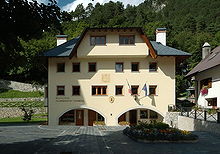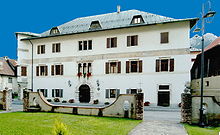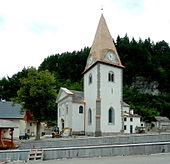Malborghetto Valbruna
| Malborghetto Valbruna | ||
|---|---|---|

|
|
|
| Country | Italy | |
| region | Friuli Venezia Giulia | |
| Coordinates | 46 ° 30 ' N , 13 ° 26' E | |
| height | 721 m slm | |
| surface | 120 km² | |
| Residents | 908 (Dec. 31, 2019) | |
| Population density | 8 inhabitants / km² | |
| Post Code | 33010 | |
| prefix | 0428 | |
| ISTAT number | 030054 | |
| Popular name | Malborgether | |
| Patron saint | San Pietro | |
| Website | Malborghetto Valbruna | |
Malborghetto Valbruna ( Slovenian : Naborjet-Ovčja vas , German : Malborgeth-Wolfsbach , Friulian : Malborghèt Valbrune ) is a quadrilingual municipality with 908 inhabitants (as of December 31, 2019) in the Canal Valley in the Friuli-Venezia Giulia region .
geography
Geographical location
The municipality is located in the central channel valley between the municipalities of Tarvisio (Tarvis) in the east and Pontebba (Pontafel) in the west.
The main towns are characterized by the mountain peaks of the Carnic Alps in the north and the Julian Alps in the south: the Jôf di Montasio (Montasch, 2754 m), the Jôf Fuârt (Wischberg, 2666 m), the Jôf di Miezegnot (Mittagskofel, 2087 m), the Monte Osternig (Oisternig, 2052 m) and the Monte Poludnig (Poludnig, 2000 m). The Val Saisera (Seiseratal) is located in a southern side valley of the Fella , crossed by the Saisera mountain stream . The Monte Santo di Lussari (Luschariberg, 1788 m) is also located here.
Neighboring communities
| Hermagor-Pressegger See | Feistritz an der Gail , Sankt Stefan im Gailtal | Hohenthurn |
| Pontebba |

|
Tarvisio |
| Chiusaforte | Dogna |
Community structure
The districts (fractions) are Bagni di Lusnizza (Lußnitz), Cucco (Gugg), Malborghetto (Malborgeth), Santa Caterina (St. Kathrein), Ugovizza (Uggowitz) and Valbruna (Wolfsbach).
history
Until the High Middle Ages, the community with the then name Bambergedt (-edt = good, property), like the entire Canal Valley , belonged to the bishops of Bamberg and gained economic importance at that time. The name developed over time to Buonborgeth (buon = good) and finally, after the place was burned down by the Venetians after disputes with Venice at the end of the 14th century, to Malborgeth (mal = bad). The flourishing iron production and timber industry contributed to the economic development of the village, which is still the seat of handicrafts and small industrial businesses.
The Habsburgs built a fortification there (now called Fort Hensel ), which was occupied by the Venetians in 1616, by the French general André Masséna in 1797 and by the viceroy Eugène de Beauharnais in 1805.
From May 14 to 17, 1809, an Austrian unit under Captain Friedrich Hensel defended the fortress for four days against 15,000 French soldiers under Eugène de Beauharnais until it fell on May 17. Of the 390 Austrians, 350 were killed. Due to the loss of time, the French corps could no longer intervene in the battle of Aspern , which contributed to Archduke Charles' victory .
In 1880 the then market town of Malborgeth had 894 inhabitants. Of these, 774 were German (87%) and 66 Slovenian (7%).
After the end of the First World War, Malborgeth and the entire Canal Valley fell to Italy in 1919, although it was populated exclusively by people of German and Slovene descent. At the end of August 2003 a flood with mudslides caused damage amounting to millions.
tourism
Together with the villages of Valbruna (Wolfsbach) and Ugovizza (Uggowitz), the area represents an important region for summer retreat and winter sports. The place is also a starting point for hikes in the Julian Alps .
Attractions
Malborghetto
- The Palazzo Veneziano (17th century), used as an ethnographic museum of the municipalities in Montana-Canal del Ferro-Valcanale .
- The single-nave Gothic parish church of Santa Maria was restored in 1809 . The nave has a ribbed vault. Remnants of Gothic frescoes and stones from the 16th and 17th centuries were uncovered.
Baptismal font in the parish church
- Memorial to the fallen and remains of the Fort Hensel dam near Malborghetto
Ugovizza
- The Church of Saints Philip and Jacob ; Inside are numerous frescoes that were uncovered in 1959 . The church tower was torn away by the flood of August 29, 2003, and has been completely restored since 2009.
literature
- Roberta Costantini, Fulvio Dell'Agnese, Micol Duca, Antonella Favaro, Monica Nicoli, Alessio Pasian: Friuli-Venezia Giulia. I luoghi dell'arte , pp. 273-274; Bruno Fachin Editore, Trieste
- Anna Zanier with Claudio Canton e Roberto Carollo ed il contributo di Mauro Bigot: La strada ferrata della Pontebba , 2006 Senaus, Udine; ISBN 88-901571-5-1
- Guida del Friuli: VII. Val Canale , Udine 1991; Societá Alpina Friulana
- Claudia Fräss-Ehrfeld (ed.): Napoleon and his time, Carinthia - Inner Austria - Illyria (pages 153-198). Verlag des Geschichtsverein für Kärnten, Klagenfurt 2009, ISBN 978-3-85454-113-4 .
Web links
Individual evidence
- ↑ Statistiche demografiche ISTAT. Monthly population statistics of the Istituto Nazionale di Statistica , as of December 31 of 2019.
- ↑ Kurt F. Strasser, Harald Waitzbauer, Across the borders to Triest (Vienna 1999), p. 64.
- ^ Digby Smith: The Greenhill Napoleonic Wars Data Book , p. 304. London 1998. ISBN 1-85367-276-9
- ↑ KK Statistische Central-Commission, Special-Orts-Repertorien of the kingdoms and countries represented in the Oesterreichischen Reichsrathe. Volume V Carinthia (Vienna 1883) p. 67.






















